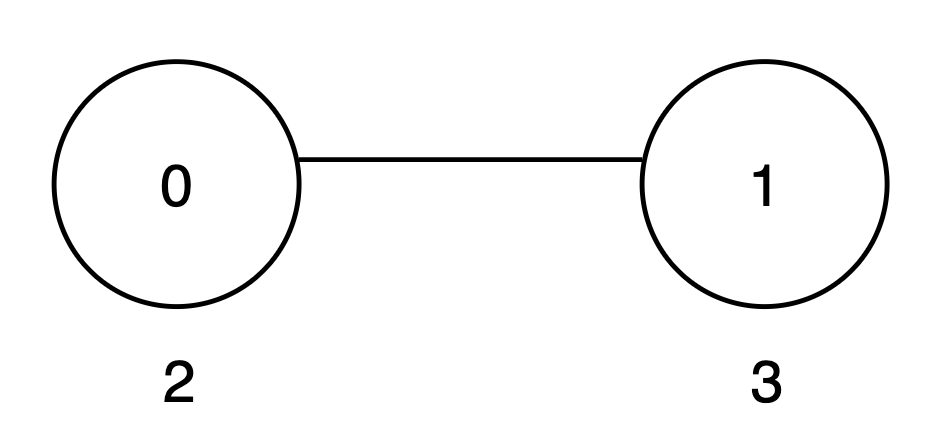Description
You are given an undirected tree rooted at node 0 with n nodes numbered from 0 to n - 1. Each node i has an integer value vals[i], and its parent is given by par[i].
A subset of nodes within the subtree of a node is called good if every digit from 0 to 9 appears at most once in the decimal representation of the values of the selected nodes.
The score of a good subset is the sum of the values of its nodes.
Define an array maxScore of length n, where maxScore[u] represents the maximum possible sum of values of a good subset of nodes that belong to the subtree rooted at node u, including u itself and all its descendants.
Return the sum of all values in maxScore.
Since the answer may be large, return it modulo 109 + 7.
Example 1:
Input: vals = [2,3], par = [-1,0]
Output: 8
Explanation:

- The subtree rooted at node 0 includes nodes
{0, 1}. The subset{2, 3}is good as the digits 2 and 3 appear only once. The score of this subset is2 + 3 = 5. - The subtree rooted at node 1 includes only node
{1}. The subset{3}is good. The score of this subset is 3. - The
maxScorearray is[5, 3], and the sum of all values inmaxScoreis5 + 3 = 8. Thus, the answer is 8.
Example 2:
Input: vals = [1,5,2], par = [-1,0,0]
Output: 15
Explanation:

- The subtree rooted at node 0 includes nodes
{0, 1, 2}. The subset{1, 5, 2}is good as the digits 1, 5 and 2 appear only once. The score of this subset is1 + 5 + 2 = 8. - The subtree rooted at node 1 includes only node
{1}. The subset{5}is good. The score of this subset is 5. - The subtree rooted at node 2 includes only node
{2}. The subset{2}is good. The score of this subset is 2. - The
maxScorearray is[8, 5, 2], and the sum of all values inmaxScoreis8 + 5 + 2 = 15. Thus, the answer is 15.
Example 3:
Input: vals = [34,1,2], par = [-1,0,1]
Output: 42
Explanation:

- The subtree rooted at node 0 includes nodes
{0, 1, 2}. The subset{34, 1, 2}is good as the digits 3, 4, 1 and 2 appear only once. The score of this subset is34 + 1 + 2 = 37. - The subtree rooted at node 1 includes node
{1, 2}. The subset{1, 2}is good as the digits 1 and 2 appear only once. The score of this subset is1 + 2 = 3. - The subtree rooted at node 2 includes only node
{2}. The subset{2}is good. The score of this subset is 2. - The
maxScorearray is[37, 3, 2], and the sum of all values inmaxScoreis37 + 3 + 2 = 42. Thus, the answer is 42.
Example 4:
Input: vals = [3,22,5], par = [-1,0,1]
Output: 18
Explanation:
- The subtree rooted at node 0 includes nodes
{0, 1, 2}. The subset{3, 22, 5}is not good, as digit 2 appears twice. Therefore, the subset{3, 5}is valid. The score of this subset is3 + 5 = 8. - The subtree rooted at node 1 includes nodes
{1, 2}. The subset{22, 5}is not good, as digit 2 appears twice. Therefore, the subset{5}is valid. The score of this subset is 5. - The subtree rooted at node 2 includes
{2}. The subset{5}is good. The score of this subset is 5. - The
maxScorearray is[8, 5, 5], and the sum of all values inmaxScoreis8 + 5 + 5 = 18. Thus, the answer is 18.
Constraints:
1 <= n == vals.length <= 5001 <= vals[i] <= 109par.length == npar[0] == -10 <= par[i] < nforiin[1, n - 1]- The input is generated such that the parent array
parrepresents a valid tree.
Solution
Python3
class Solution:
def goodSubtreeSum(self, vals: List[int], par: List[int]) -> int:
N = len(vals)
M = 10 ** 9 + 7
graph = defaultdict(list)
ans = 0
for node, p in enumerate(par):
if p != -1:
graph[p].append(node)
def isDup(d, mask):
newMask = mask
while d > 0:
rem = d % 10
if newMask & (1 << rem) == 0:
newMask |= (1 << rem)
else:
return True, mask
d //= 10
return False, newMask
def helper(node):
nonlocal ans
A = [vals[node]]
for adj in graph[node]:
child = helper(adj)
A.extend(child)
@cache
def dp(index, mask):
if index == len(A): return 0
# skip
curr = dp(index + 1, mask)
# take if it's valid
isDuplicate, newMask = isDup(A[index], mask)
if not isDuplicate:
curr = max(curr, A[index] + dp(index + 1, newMask))
return curr
res = dp(0, 0)
ans += res
ans %= M
return A
helper(0)
return ans